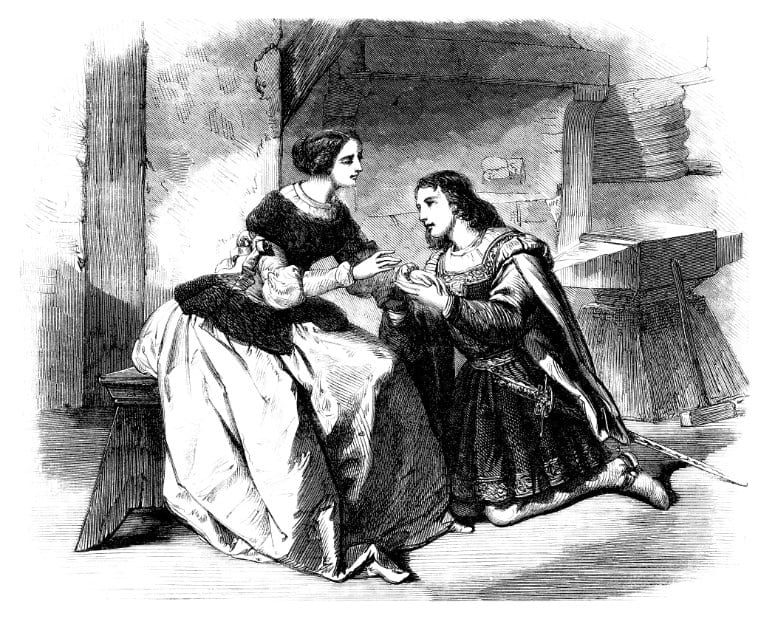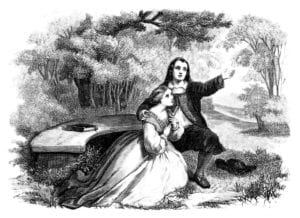Clothes mattered to the Elizabethans. What people wore was a legal matter, governed by the Sumptuary Laws. This legal system, as the name implies, was intended to regulate consumption, but it also had the effect of limiting social mobility and aspiration. Among other restrictions imposed by the Sumptuary Law of 1363, wives and daughters of servants were barred from wearing veils worth more than one shilling, while for wives and daughters of knights, it was illegal to wear cloth of gold. Colours too were subject to proscription, with red and purple limited to members of the governing class.
Clothes matter in Shakespeare too. There are times in his plays when they are used as disguises – and not always for nefarious purposes. One thinks of Henry V on the eve of Agincourt, borrowing the cloak of Sir Thomas Erpingham in order to disguise his real status as he ventures out among his troops to assess their loyalty and test their mettle for the morrow. The guise succeeds, and he enjoys frank conversations with his men, even discussing his own merits as king. His disguise is not rumbled. Autolycus, in ‘The Winter’s Tale’, similarly uses clothes as disguise, exchanging his pedlar’s coat with Florizel’s more desirable jacket so as to enable the young prince to escape his own kingdom. All quite innocent.
Elsewhere in his plays, Shakespeare uses clothes for more sinister purposes. One thinks of Malvolio, steward to Olivia in ‘Twelfth Night’, tricked into sporting yellow stockings as a cruel practical joke that encourages him to think that he has caught his mistress’s eye – whereas in practice he has been merely fooled. There is evidence to suggest that yellow stockings may have indicated sexual licence and marital infidelity in early modern London, thus reinforcing the puritan Malvolio’s humiliation.
There are numerous occasions elsewhere where characters are deceived by what one might call sartorial misunderstandings. In ‘Cymbeline’, for example, Cloten expresses his lust for the king’s daughter Imogen by dressing in clothes belonging to her exiled lover Posthumus. Cloten then follows the object of his unwelcome desires to Wales where Roman troops are disembarking ready for their invasion of Britain – and there he is killed. When Imogen discovers his headless body dressed in the clothes of her lover, the conclusion she draws is predictable. Later, when she discovers the true identity of the corpse, her relief can be imagined.
Clothes are a badge of identity – then as now. They symbolise status and calling – one thinks of Prospero in ‘The Tempest’, who removes his mantle (or cloak) twice in the course of the play. The first occasion is when he describes to Miranda her childhood and background – a sensitive moment, perhaps – the second at the play’s end, when he renounces his magic, his art. Clothes generally play an important role in the play: Gonzalo is surprised that though his party has been shipwrecked, his clothes are as good as new; later, when Caliban leads Stephano and Trinculo to murder Prospero, they are waylaid by the sight of ‘glistering apparel’ hanging on a line. Caliban’s response is uncompromising: ‘let it alone, thou fool’, he exclaims. ‘It is but trash’. Caliban is right – the gown is a decoy, laid by Prospero to bemuse his would-be assailants.
But perhaps the most prominent role for clothing in Shakespeare is as a means of disguising female characters keen to play their part in the wider world. True, the reason why Jessica in ‘The Merchant of Venice’ dresses as a boy is to escape her father, but later in the play, Portia (and Nerissa) will assume the garb appropriate to a lawyer and his clerk as they fight and win their court case ‘accoutred’ (as Portia puts it) ‘like young men’. Julia in ‘The Two Gentlemen of Verona’ has a similar strategy: intending to travel to Milan to catch up with her lover Proteus, she calls on her maid Lucetta to ‘fit me with such weeds [clothes] / As may beseem some well-reputed page’. The idea is to avoid the wrong kind of attention on her journey, and dressing as a ‘page’ will disguise her real identity.
Clothing in Shakespeare does not invariably make life easier. True, Falstaff escapes the wrath of the husbands whose wives he is preying on in ‘The Merry Wives of Windsor’ by hiding among the contents of the laundry basket – thence to be unceremoniously dumped into the Thames – but the fate of Ophelia in ‘Hamlet’ is the reverse. Polonius’s ill-fated daughter dies partly because, when she slips into the stream that drowns her, the dress she is wearing becomes drenched, and ‘her garments, heavy with their drink, / Pulled the poor wretch from her melodious lay / To muddy death’. Whether or not this was suicide the grave-diggers will later question, prelude to four centuries of discussion.
In general, then, the significance of clothing in Shakespeare’s plays revolves around issues of gender, status and identity – much as it does today. The Sumptuary Laws are always somewhere in the background, the sense that clothing is a matter of prescription and proscription. Macbeth echoes this theme when he is told in the opening act that he is to be promoted Thane of Cawdor: ‘the Thane of Cawdor lives’, he responds; ‘why do you dress me / In borrow’d robes?’ The truth is that many of Shakespeare’s most memorable scenes – Portia in the Venetian court, Henry V on the night before Agincourt, Cloten’s headless body mistaken for Posthumus, Malvolio sporting his new yellow stockings – feature borrowed robes in the most literal sense.




